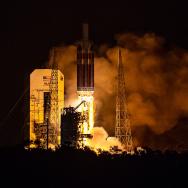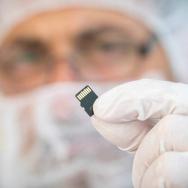NASA’s Parker Solar Probe lifted off at 2:31 a.m. CDT Aug. 12, beginning a historic mission that will bring a spacecraft closer to the sun than any ever before.
Watching from the Kennedy Space Center in Florida was University of Chicago Prof. Emeritus Eugene Parker, who has dedicated his life to unraveling the sun’s mysteries. He is the first living person to have a spacecraft named after him and at the age of 91 became the first person to see his namesake mission thunder into space.
A media briefing was held July 31 in downtown Chicago for the upcoming NASA launch of the Parker Solar Probe. The mission to fly closer to the sun than ever before is the first spacecraft named after a living person: 91-year-old University of Chicago scientist Eugene Parker.
The event included a panel discussion with Parker, mission scientist Nicola Fox with the Johns Hopkins Applied Physics Lab, UChicago Dean of Physical Sciences Angela Olinto and NASA heliophysicist Alex Young.
NASA space missions named after UChicago scientists
Prof. Emeritus Eugene Parker is the first living person to have a NASA mission named after him: the Parker Solar Probe, set to launch in August 2018. This honor extends UChicago’s legacy of excellence in astronomy and astrophysics throughout the past century. Parker is following in the footsteps of fellow UChicago scientists Edwin Hubble, Subrahmanyan Chandrasekhar, Enrico Fermi and Arthur Holly Compton, who all received the honor of a named spacecraft posthumously.
NASA names solar mission after UChicago physicist
NASA has named the first mission to fly a spacecraft directly into the sun’s atmosphere in honor of Prof. Eugene Parker, a pioneering physicist at the University of Chicago. The Parker Solar Probe will launch next summer on a mission to fly within 4 million miles of the sun’s surface to study the star with unprecedented precision.
Parker is best known for developing the concept of solar wind—the stream of electrically charged particles emitted by the sun. He was honored May 31, 2017 at a public celebration on campus that included colleagues and students from UChicago and leaders from NASA and the Johns Hopkins University Applied Physics Laboratory.
NASA space missions named after UChicago scientists 1/12
Learn more at the NASA mission website: https://www.nasa.gov/content/goddard/parker-solar-probe


































